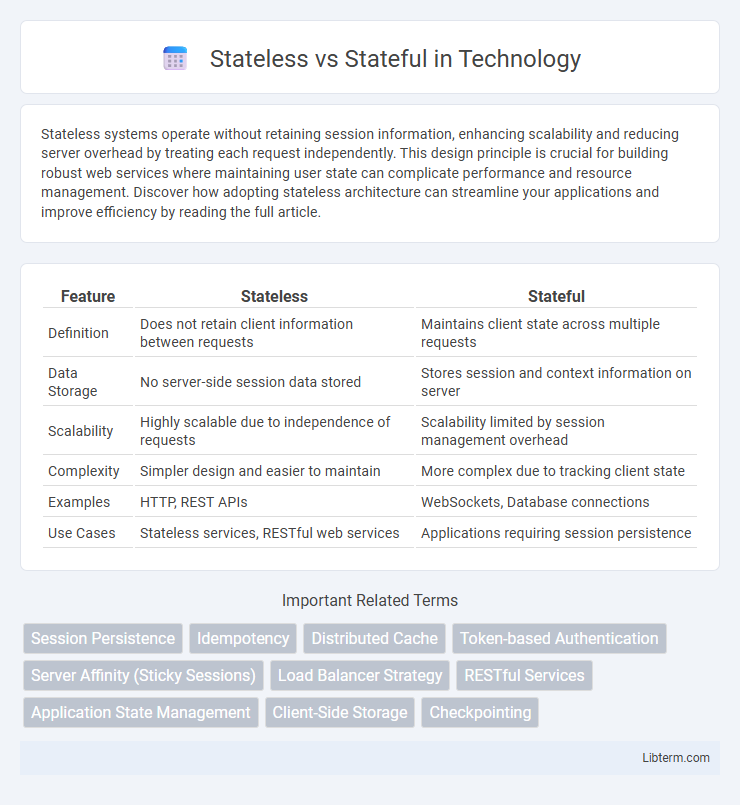Stateless systems operate without retaining session information, enhancing scalability and reducing server overhead by treating each request independently. This design principle is crucial for building robust web services where maintaining user state can complicate performance and resource management. Discover how adopting stateless architecture can streamline your applications and improve efficiency by reading the full article.
Table of Comparison
| Feature | Stateless | Stateful |
|---|---|---|
| Definition | Does not retain client information between requests | Maintains client state across multiple requests |
| Data Storage | No server-side session data stored | Stores session and context information on server |
| Scalability | Highly scalable due to independence of requests | Scalability limited by session management overhead |
| Complexity | Simpler design and easier to maintain | More complex due to tracking client state |
| Examples | HTTP, REST APIs | WebSockets, Database connections |
| Use Cases | Stateless services, RESTful web services | Applications requiring session persistence |
Understanding Stateless and Stateful Architectures
Stateless architectures treat each request as an independent transaction, with no knowledge of previous interactions, enabling scalability and simpler load balancing. Stateful architectures maintain session information or context between requests, allowing for personalized user experiences and continuous interactions. Understanding these differences is crucial for designing systems that balance performance, resource management, and user requirements.
Key Differences Between Stateless and Stateful Systems
Stateless systems treat each request as an independent transaction, without retaining user data between interactions, which enhances scalability and simplifies failure recovery. Stateful systems maintain context and user information across sessions, enabling personalized experiences but requiring more memory and complex management. The choice between stateless and stateful depends on application needs, where stateless is ideal for RESTful APIs and scalable web services, while stateful suits applications needing persistent sessions like databases and user interfaces.
Advantages of Stateless Design
Stateless design improves scalability by eliminating the need to store client session data on the server, allowing requests to be handled independently and distributed across multiple servers effortlessly. It enhances reliability since each request contains all necessary information, reducing dependency on previous interactions and minimizing server memory usage. This approach simplifies caching and load balancing, resulting in faster response times and easier maintenance for distributed web applications.
Benefits of Stateful Architecture
Stateful architecture enhances application performance by maintaining client session information, enabling faster data retrieval and personalized user experiences. It improves reliability through continuous data tracking, which supports complex transactions and reduces the risk of data loss. This approach also simplifies debugging and monitoring by preserving context across interactions, facilitating efficient issue resolution.
Common Use Cases for Stateless Systems
Stateless systems are widely used in web services and APIs for efficient scalability and load balancing, as each request is processed independently without reliance on stored session data. Cloud environments and microservices architecture frequently employ stateless designs to enhance fault tolerance and simplify horizontal scaling. Content delivery networks (CDNs) also benefit from statelessness, enabling rapid content distribution without maintaining client-specific state information.
Typical Applications of Stateful Systems
Stateful systems are widely used in applications requiring continuous interaction and context preservation, such as online banking platforms where user sessions must securely track transactions and authentication status. Enterprise resource planning (ERP) software relies on stateful mechanisms to manage complex workflows and inventory data across departments in real-time. Stateful applications also dominate multiplayer online gaming, maintaining player states and game progress for immersive and consistent user experiences.
Performance and Scalability Considerations
Stateful systems maintain session information, which can increase latency and resource consumption, limiting scalability across distributed environments. Stateless architectures enhance performance by processing each request independently, enabling effortless horizontal scaling and optimized load balancing. Cloud-native applications often prefer stateless designs to achieve lower response times and improved fault tolerance in large-scale deployments.
Security Implications: Stateless vs Stateful
Stateful systems maintain session information, allowing continuous authentication and enabling robust security features like tracking user activity and preventing unauthorized access through state validation. Stateless systems do not store session data between requests, which reduces server overhead but increases reliance on tokens like JWTs for authentication, posing risks if tokens are intercepted or improperly managed. Security in stateful architectures benefits from inherent session controls, while stateless designs require stringent token encryption, expiration, and verification mechanisms to mitigate vulnerabilities.
Choosing the Right Approach for Your Application
Choosing between stateless and stateful architectures depends on your application's requirements for scalability, complexity, and user session management. Stateless designs excel in distributed systems and microservices by simplifying load balancing and fault tolerance through independent request handling. Stateful applications are better suited for environments where maintaining user context and session data is critical, such as in online gaming or banking platforms.
Future Trends in Stateless and Stateful Computing
Future trends in stateless computing emphasize the expansion of serverless architectures and microservices, enabling scalable, cost-efficient cloud applications with minimal session management. Stateful computing advances focus on integrating edge computing and AI-driven state management to maintain persistent data and context in real-time applications such as IoT and autonomous systems. Hybrid models combining stateless scalability with stateful context-awareness are emerging, optimizing performance and user experience across distributed environments.
Stateless Infographic

 libterm.com
libterm.com